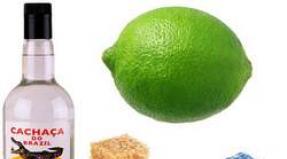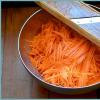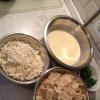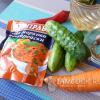What to cook with a can of red beans. Canned beans (red)
Do you want to normalize your state of mind and lift your spirits? Eat beans. Don't be surprised - beans are really not as simple as they seem at first glance. It contains everything that is necessary for normal human performance and functioning: a large amount of starch, carbohydrates and a huge range of vitamins. No wonder it is considered one of the 10 most useful products. Therefore, it is very important that such a product is on your table all year round. Beans can be used to prepare a wide variety of nutritious dishes. Both fresh and after heat treatment, beans are added to salads, soups, side dishes, snacks are made with them and, of course, beans are canned for the winter.
As you know, you can can both grain and green beans. And what is very important is that during the canning process, beans retain all their beneficial qualities. Which beans to preserve - white or red - is a matter of taste for each housewife, but you need to pay close attention to the appearance. Bean grains should have a smooth surface, a shiny tint and be without external damage. If your choice fell on green beans, then for preservation choose small (about 9 cm), dense, juicy pods, what is called the milk stage of maturity, with an intact surface, without spots and coarse fibers, with fruits that do not form a bulge on the surface pod. The pods themselves should break easily with a characteristic crunch. This product is best suited for your preparations. The pods can be preserved whole or cut into pieces. Having carefully selected the product needed for preservation, you can safely begin the process itself. There are many ways to preserve beans. We will talk about very simple and informative recipes for canning beans for the winter, with which you can please your family and friends both on a weekday and at the holiday table.
 Canning beans in their own juice for the winter
Canning beans in their own juice for the winter
Ingredients:
1 kg red or white beans,
500 g onions,
500 g carrots,
250 g vegetable oil,
3 tbsp. 9% vinegar,
salt, cloves, allspice peas - to taste.
Preparation:
Soak the beans overnight, changing the water several times during this time. Then rinse the beans thoroughly with running water and boil until tender. Don't overcook it! Cut the onion into half rings, the carrots into circles, which then cut in half. Pour vegetable oil into the pan, put the onions and carrots in there, simmer for 20 minutes after boiling over low heat, then add the beans, let simmer for another 5-10 minutes, add vinegar, salt, cloves and allspice and cook for another 2-3 minutes. Then pour the mixture into clean jars, sterilize for 20 minutes and seal. Turn the jars upside down and wrap them up.

Pickled beans for the winter “Natural”
Ingredients for 1 liter of water:
40 g salt,
40 g sugar,
1 tsp 70% vinegar,
cloves, black peppercorns, other spices - to taste.
Preparation:
Place the beans in a saucepan and cover with water. The beans should be well covered with water, as some of it will evaporate and some will be absorbed into the beans. Add salt, sugar, spices, put the pan on the fire and cook for 1.5 hours until soft. A few minutes before the end of cooking, add vinegar. Place the finished beans in sterilized jars, roll up, wrap and let cool.
Canned beans in tomato sauce
Ingredients:
1 kg beans (any variety),
3 kg tomatoes,
3 tsp salt,
2 tsp Sahara,
half a pod of hot pepper,
10 peas of allspice,
several bay leaves.
Preparation:
Soak the beans, rinsing thoroughly, for 4 hours. When it gets wet, place it in a saucepan, pour in 4 liters of water and cook over low heat, adding 1.5 tsp. salt and 2 tsp. Sahara. Don't forget to stir it from time to time. After 30 minutes, drain the beans in a colander and start preparing the tomato puree. First, peel the tomatoes by pouring boiling water over them, and then pass them through a meat grinder or grind in a blender. Place the finished puree and beans in a saucepan, add the remaining salt, chopped allspice and finely chopped hot pepper. Cook the mixture over low heat for 20-30 minutes, slightly covering with a lid and stirring from time to time. A few minutes before cooking, add the bay leaf. Place the finished product in sterilized jars, roll up, turn upside down and wrap. As they say, there are no friends for taste and color, but white beans look more beautiful in tomato sauce.

Canned white beans with dill and parsley
Ingredients:
1 kg beans,
1 kg of tomatoes,
3 bunches of parsley,
3 bunches of dill,
salt, pepper - to taste.
Preparation:
Soak the beans in cold water for 5 hours. Then drain in a colander, rinse and dry a little. Boil salted water in a large saucepan and place the beans in it. It should cook until half cooked. Grate ripe tomatoes, add salt and pepper, mix with finely chopped herbs, bring to a boil and leave to simmer over low heat. Place the beans cooked until half cooked into sterilized jars, leaving 3-4 cm to the top, and pour boiling tomato mixture over them. Cover with lids and sterilize for 80 minutes. Then roll up the jars, turn them upside down and wrap them until they cool completely.

Canned red beans with vegetables
Ingredients:
6 stacks beans,
3 kg tomatoes,
2 kg carrots,
2 kg onions,
2 bunches of dill,
1 pod of hot pepper,
500 ml vegetable oil,
2.5 tbsp. salt,
2 tbsp. Sahara,
1 tbsp. 9% vinegar essence.
Preparation:
Soak the beans overnight, then boil them for 1 hour until half cooked. Cut the onion into half rings and fry, cut the carrots into strips or grate on a coarse grater for Korean salads and also fry. Finely chop the greens and mince the hot peppers. Also mince the tomatoes, combine with fried onions and carrots and boil in a saucepan for 15 minutes, then add the beans and other ingredients to the mixture and cook for 30 minutes. After the time has passed, place the finished hot beans into sterilized jars, roll them up, turn them upside down and wrap them well until they cool completely.

Pickled green beans
Ingredients:
1 kg green beans.
For the marinade (per 1 liter of water):
1 tbsp. salt,
100 g sugar,
70 ml 6% vinegar.
Preparation:
Cut the pods into pieces and blanch in boiling water for several minutes, place in half-liter jars and fill with marinade made from water, salt, sugar and vinegar. Sterilize the jars for 15-20 minutes, roll them up, turn them upside down and leave until cool.
Green beans "Dacha secrets"
Ingredients for a 1 liter jar:
600 g green beans,
2 g horseradish
50 g dill,
2 g parsley,
3 g cinnamon,
2 carnations,
5 black peppercorns.
For the marinade (per 1 liter of water):
25 g salt,
20 g sugar,
15 ml 70% vinegar.
Preparation:
Cut the pods into small pieces of 3 cm, blanch for 2-3 minutes and place tightly in jars mixed with spices. Prepare the marinade: pour water into a saucepan, add salt and sugar, boil for 10-15 minutes. Then strain it through cheesecloth and add vinegar. Fill the filled jars with marinade and sterilize: 0.5 liter jars - 5 minutes, 1 liter - 8 minutes, 3 liters - 15 minutes. Roll it up and wrap it up immediately.

Asparagus beans with bell pepper “Favorite”
Ingredients:
2 kg green beans,
250 g bell pepper,
2 bunches of parsley,
70 g garlic.
For the marinade:
700 ml water,
150 ml vegetable oil,
70 g salt,
100 g sugar,
1 stack 6% vinegar.
Preparation:
Prepare the marinade, boil and add ground garlic, chopped pepper, finely chopped herbs, stir and bring to a boil again. Peeled bean pods, if they are large, cut them into pieces; if not, leave them whole and dip them in the marinade. Stirring lightly, bring to a boil. Boil for 35 minutes until the beans sink to the bottom and are coated with the marinade. Place the finished product in jars and roll up.
Green beans “With peppercorn”
Ingredients:
1 kg green beans,
1 kg of tomatoes,
250 g garlic,
3 pods of hot pepper,
salt - to taste.
Preparation:
Peel the beans from the veins and blanch in boiling water for 1-2 minutes, then drain in a colander and dry. Pass the garlic and hot pepper through a meat grinder and add salt - 50 g of salt per 1 kg of hot mixture. Layer the garlic mixture, chopped fresh tomatoes and beans into the bottom of a sterilized jar. Repeat layers. Cover with a clean napkin and place a weight on top. After a week, distribute the mixture into jars, sterilize liter jars for 20 minutes, roll up and wrap until cool.

Green beans "Spicy"
Ingredients:
500 g green beans.
For the marinade:
100 ml water,
4 tbsp. 9% vinegar,
1 tsp Sahara,
2 cloves of garlic,
1 tbsp. mustard with grains,
2 tbsp. vegetable oil.
Preparation:
To prepare the marinade, pass the peeled garlic through a press. Add salt, sugar, mustard to it and mix well. Pour in vinegar, water, vegetable oil and mix again. Boil the beans until tender, cool. Pack the beans into a half-liter jar and pour in the marinade. Sterilize the jar for 15-20 minutes and roll up.
Green bean salad with eggplant “Memories of Summer”
Ingredients:
1.2 kg green beans,
3 liters of tomatoes minced through a meat grinder,
500 g eggplants,
600 g sweet pepper,
1.5 stack. vegetable oil,
1.5 stack. Sahara,
3 tbsp. l. salt,
1.5 tbsp. 9% vinegar.
Preparation:
Pour vegetable oil and vinegar into the tomato puree, add salt and sugar, and boil for 15 minutes. Then add the beans and simmer for another 20 minutes. Add the eggplants cut into small pieces and boil again for 20 minutes. Then add the pepper, cut into small strips, and boil for another 20 minutes. At the end of cooking, place the salad in sterilized jars, roll up, turn upside down and wrap.

Snack of green beans and beets “I want more”
Ingredients:
700 g green beans,
500 g beets,
250 g sweet pepper,
250 g onions,
500 g tomatoes,
1 stack vegetable oil,
70 g garlic,
1 bunch of parsley,
½ cup 6% vinegar,
hot pepper and spices - optional.
Preparation:
Grate the beets on a coarse grater. Pass the tomatoes through a meat grinder, cut the beans into small cubes, finely chop the onion, pepper and herbs. Pour vegetable oil into the pan, place the onion in it and sauté for 10-15 minutes, then pour in the tomato puree, vinegar, salt, sugar, bell pepper, parsley, and garlic. Stir everything well, heat it up, pour in the beets and beans and boil for an hour over medium heat in a sealed container, stirring from time to time. Place the finished snack in sterilized jars and roll up.
 Salad with green beans “Autumn Kaleidoscope”
Salad with green beans “Autumn Kaleidoscope”
Ingredients:
250 g green beans,
250 g leeks,
250 g cauliflower,
250 g zucchini,
250 g carrots,
500 g ripe tomatoes,
500 g sweet pepper.
For filling:
1 liter of water,
1 tbsp. salt,
2 tbsp. Sahara,
2 tsp citric acid,
dill seeds, garlic - to taste.
Preparation:
Cut the beans into small pieces and blanch for 1-2 minutes. Also cut the leek into small pieces, divide the cauliflower into inflorescences. Cut the zucchini and carrots into small cubes. Blanch the prepared leek pieces, cauliflower florets, zucchini and carrot cubes for 2 minutes. Dip tomatoes and peppers, peeled from seeds, into boiling water and cut: tomatoes into thin slices, peppers into rings. Mix all the vegetables and place in sterilized liter jars. Prepare the filling: add salt, sugar, citric acid, seasonings to the water and bring to a boil. Pour the prepared filling over the vegetables in the jars, add finely chopped garlic to each of them. Sterilize the jars for 25 minutes and seal.
Bean preparation"Simple, but tasteful." Cut off the tails of green beans on both sides and place the pods in liter jars. Place 1 tbsp in each liter jar. salt and fill the pods ⅓ full with water, close the lids and sterilize for 3 hours from the moment of boiling. Roll it up and turn it over.
Of course, canning beans will require you to invest time and effort, but every jar of beans opened in winter brings a great mood to the whole family!
Happy preparations!
Larisa Shuftaykina
Canned beans It can be either white or red (see photo). Only those options that are made using only 4 ingredients can be considered a quality product: water, salt, sugar, and the beans themselves. Sometimes acetic acid may also be present in such a product. Although today you can find beans in tomato or some sauce.
It is believed that canning is the most reliable way to store this product. Moreover, to eat such beans, you do not need to boil or soak them, like the dried version, just rinse them. For vegetarians, canned beans occupy one of the leading positions in the list of favorite products.
Beneficial features
It has been scientifically proven that canned beans retain up to 80% of nutrients, which means that the benefits of the product are proven. Since this type of vegetable contains quite a few calories and, accordingly, their energy value is low, these beans can easily be used in dietary nutrition and can also be included in the menu during weight loss. The main thing is to choose this kind of preservation without the use of animal fats, otherwise the dream of losing weight will not come true, because the calorie content with this method of conversion can increase significantly. Canned beans contain plant fiber, which has a positive effect on the intestinal microflora and also prevents the occurrence of various inflammations and cancerous tumors.
Canned beans have the ability to normalize carbohydrate metabolism in the body, and they also resist the formation of cholesterol. It is also worth appreciating that this product has the ability to quickly saturate the body and replenish the energy balance.
Use in cooking
Canned beans stand out because they go well with other products, not only of plant, but also of animal origin. This product has a rather pleasant and delicate taste, thanks to which it can be used as an independent side dish for meat and fish dishes. In addition, canned beans can be added to various salads and snacks. It can also be pureed and served as a separate side dish. You can also add a variety of spices to this product, which will improve and diversify the taste of the dish. Canned beans can also be used as a filling for a variety of baked goods. In addition, this product is used as a thickener for sauces and first courses.
The benefits of canned beans and treatment
The benefits of canned beans were assessed after several experiments showed that this product has the ability to protect the body from the effects of free radicals.
Harm of canned beans and contraindications
Canned beans will cause harm if you exceed the permissible limit, as this can lead to flatulence. Due to the fact that this type of vegetable contains quite a lot of salt, people who suffer from various diseases of the kidneys, liver, stomach, and intestines should avoid eating this product. Contraindications to the use of this product include colitis, nephritis, gout, cholecystitis and nephritis. People with diabetes should not eat canned beans often. It is also worth regulating the permitted dose of beans for children, no more than 100 g daily.
Beans are one of the most common and healthy legumes that we eat. Nutritionists believe that this product should be constantly included in the diet of an adult to enrich the body with amino acids and vegetable protein. The fruits of this plant require careful processing, so for many housewives today it is easier to buy canned beans than to cook them themselves. Its benefits are just as broad and deep, but if used incorrectly, this product can cause harm.
Product Features
Many experts consider canning beans to be one of the most reliable and effective ways to store them. During the production process, the beans are boiled and sealed in a metal or glass jar with a special syrup, which ideally consists of water, salt and sugar. According to the state standard, acetic acid may be found with them, but in fact today you can find other preservatives and food additives. Such products are usually sold under the specifications label, and the benefits and harms from their use are unpredictable. In any case, before cooking, the liquid from the jar must be poured out and the beans must be thoroughly washed under running water.
The advantage of beans produced “in glass” is obvious - the buyer can evaluate not only the information provided by the manufacturer, but also the appearance of the product. However, this packaging format is very rare in our country. All varieties of beans can be preserved, but in Russia and the CIS only white and red ones are found. The size of the fruit, according to GOST, should be 6-10 mm. This rule is important because the beans are cooked for a certain amount of time during production. If the raw material is too large in size, it will not be reliably processed - toxins will remain in the pulp. Such food does more harm than good. Peas that are too small cannot be used either, because they will boil and mix with the syrup.

Composition and beneficial properties
The calorie content and nutritional value of canned beans is not much different from those that we can cook ourselves at home. This is due to the fact that in both cases many harmful elements are digested from it. Raw beans are literally saturated with nitrates and heavy metals, so eating them in this form is dangerous. The content of proteins and carbohydrates is reduced by 3 times, and along with them the calorie content becomes just as much lower - from 299 kcal to 99 kcal per 100 grams.
Despite such losses, beans remain very nutritious, their vitamin and mineral composition still looks impressive in comparison with other products:
- white beans retain 4.3 g, and red beans - 6.4 g of fiber per 100 g, which is 21% and 32% of the daily value;
- minimal proportion of fat - only 0.36 g per 100 grams;
- high content of iron, potassium, sodium, zinc, phosphorus, magnesium and selenium;
- vitamins A, B1, B2, B5, B6, B9, etc.
For the human body, canned beans are a valuable source of energy and carbohydrates, called the main building material of the body. This is a very important product for a healthy diet and weight loss, and high calorie content in this case is not at all the enemy, because it is based not on the fat component, but on the protein-carbohydrate component. It provides quick saturation with a small amount of food.
The great benefits for digestion are due to the high content of dietary fiber. As they pass through the intestines, they remove food debris and other waste products, and also perform a gentle massage of the walls. The result is improved blood circulation and absorption. By stimulating intestinal motor functions, canned beans help cope with chronic constipation.
The benefit of this canned legume also lies in a large amount of B vitamins. The condition of the skin, tissues, hair, teeth, and nails depends on their presence in the body. Some of them are antioxidants involved in cancer prevention. To one degree or another, B vitamins are necessary for the proper functioning of the endocrine, circulatory, digestive, nervous systems, and normal metabolism.
The rejuvenating effect of eating beans is enhanced by vitamin E, which acts in combination with antioxidants and other vitamins. It is also an important element for preventing infertility in women.
Beans well stimulate carbohydrate and protein metabolism, due to which cells and tissues are enriched with useful substances. This product is of great benefit for overweight people and the elderly - it not only allows you to feel full with a small amount of food, but also helps remove cholesterol from the blood. And many antioxidants, such as zinc, tocopherol and others, prevent the development of cancer tumors.
Canned white beans are valued for their high sodium content, one of the key elements necessary to maintain water-salt balance. In combination with chlorine, it prevents blood from leaking from blood vessels into tissues. Sodium deficiency is one of the reasons for weakening muscle activity.

Iron and potassium, the content of which in beans also exceeds that in many other products, is needed to maintain the health of the circulatory system. The first affects the composition of the blood and is involved in improving the functioning of the heart, and the second is necessary to maintain the strength and elasticity of blood vessels - the load on the heart and rhythm depend on this.
Restrictions
Eating canned beans can bring not only enormous benefits, but also harm if done without taking into account contraindications:
- For gastritis, inflammation of the digestive organs, peptic ulcers, gout, exacerbation of liver and gall bladder problems, beans should be eaten with caution. Although it has healing properties in this area, it can become too much of a burden. A specialized doctor will best help you decide on the possibility of use and quantity.
- Canned beans should be introduced into children's diets gradually so as not to overload the intestines. The same applies to older people with problems with digestive motility and obstruction.
- Doctors discourage women from eating canned beans during pregnancy and lactation. They attribute this precaution to the fact that growing and preservation conditions do not always meet standards and eating them is risky. Under normal conditions, you can try the product in small portions, observing the body’s reaction, but when carrying a fetus, it is better not to take risks.
Beans may not be to blame for poisoning or worsening a person’s condition if they were cooked incorrectly. Therefore, the choice of products purchased is of great importance:
- Give preference to beans in glass containers. They may be more expensive, but the ability to externally assess their integrity and size is worth it.
- Check the production date and expiration date. Please note that the presence of tomato paste in the product reduces the second parameter.
- The syrup in which the beans are dipped may be cloudy but smooth. Sediment at the bottom of the container is a sign of low-quality products.
- Do not buy metal cans with a bulging lid or bottom - this is a clear sign that the beans have gone bad.
- An open can of canned beans should be stored for no more than 3 days in a cool place or refrigerator.
Speaking about the benefits and harms of canned beans, first of all you should learn more about this product. It is generally accepted that canning is the ideal and most reliable option for long-term storage of this product. At the same time, to eat canned beans, you do not need to soak them or boil them for a long time, like the dried version, just rinse them with clean water and they are ready to eat. Canned beans occupy one of the highest levels in the diet of vegans and vegetarians, since they contain a large amount of protein, almost identical to that found in meat and fish. But what exactly are the benefits and harms of canned red beans, let’s look into this in more detail.
Are canned beans healthy?
Speaking about whether canned beans are useful for losing weight, it should be mentioned that this product has an average calorie content. Eating this product allows you to replenish your body with all the necessary vitamins, microelements and fiber. This product is not only acceptable, but also recommended for use by people suffering from excess weight.
When talking about the benefits or harms of canned white beans, we need to mention their main functions for the human body. The use of this product in food prevents the formation of cholesterol, normalizes carbohydrate metabolism, and provides reliable protection against the effects of free radicals. Beans contain a large amount of magnesium, calcium, potassium, protein, fiber and vitamins B, PP and A. Compared to fresh beans, the amount of protein in a canned product is reduced by three times.
Harm of canned beans
Beans can only be harmful if they are cooked incorrectly. However, this has nothing to do with the already canned product, since it is completely ready for consumption. At the same time, you should know that it is better not to abuse this product for elderly people, as well as if a person has a peptic ulcer, etc. It is not recommended to eat canned beans for children under one year of age; if beans are introduced into the baby’s diet, this should be done gradually and in very small quantities. Canned beans are not recommended for nursing mothers during the first months of breastfeeding.
Most of the plant foods we eat are healthy in one way or another. Today in our article we will look at the benefits and harms of beans, name a group of people who should definitely include them in their diet, and give the chemical composition of the product and other interesting characteristics.
White and red beans: health benefits
According to some scientists, red beans are the richest in antioxidants, that is, substances that prevent aging, protect the cardiovascular system from various problems, and help in the prevention of cancer. Considering that beans, not only red beans, but any other, contain about 20% vegetable protein, with only 2% fat and 58% carbohydrates, they can be considered as an alternative source of protein, especially for those who follow a vegetarian diet . Many components of this product help maintain the beauty of skin, hair and nails. It also reduces the level of “bad” cholesterol in the blood. Plus, these beans are simply delicious when used in side dishes, salads, and other dishes. They are a very filling product without being overly high in calories. Here they are - white or red beans, their benefits for the body are comparable to products such as currants or cranberries. Be sure to include this very inexpensive and accessible product in your diet.
What beneficial substances do beans contain?

Considering the chemical composition, we can highlight the following components of beans, the benefits of which for the body are undoubted. So, it contains:
- vitamins A, group B, in particular B1, B2 and B6, K, PP and vitamin C;
- In addition, it contains a useful and necessary antioxidant for all of us - vitamin E;
- Beans also contain large quantities of minerals - iron, calcium, phosphorus, magnesium, sodium, iodine, zinc;
- necessary acids - Omega-3, lysine, arginine and others.
In addition, beans contain a lot of fiber, which is necessary for proper digestion.
How different is the canned product from fresh beans?

Of course, no one uses this legume for food in its raw form - it is very hard, it is either boiled or rolled into jars. Canned beans, the benefits of which are quite high, retain almost all nutritional properties even with this method of preparation. Thus, it contains up to 70% of vitamins compared to a fresh product and up to 80% of minerals. Of course, there is no less protein, fat, carbohydrates and fiber in it than in the original raw materials. The only thing is, when choosing canned food in a store, pay attention to their composition. It is better if, when preparing in factory conditions, they did not use salt and other spices, but simply added water. Then the beans practically do not change in taste, and they can be perfectly used for salads or other delicious dishes.
White and red beans: benefits and harm to the body

If we talked about the nutritional and beneficial properties above in sufficient detail, then the dangers of the product should also be mentioned. Some people should take into account that this legume cannot be consumed by everyone. It should be eaten with caution by people suffering from the following diseases:
- high acidity or gastritis;
- ulcers or cholecystitis, as well as gout and colitis;
- people with a tendency to flatulence.
Keep in mind that red beans, the benefits and harms of which (especially the latter harm) differ from the same characteristics of other types of beans, cause gas formation to a lesser extent. But you still need to prepare it with caution and especially carefully. Please note that any beans are always soaked for at least several hours before cooking. Some housewives recommend adding a pinch of soda to the water - this way the beans will cook faster and become soft. Also, to reduce gas formation, it is recommended to add various spices, for example dill, to boiled porridge.
A little about green beans

This type of bean is no less healthy and just as tasty as dry red or white beans. Let's look at what features green beans have, the benefits and harms of which are described in detail below. First, let’s talk about how this product has a positive effect on the body. Firstly, it contains a large amount of vitamins - groups B, C, A, PP and a number of others. Minerals - iodine, zinc, fluorine, iron, potassium. Actually, in composition it is very similar to white and red beans, the benefits and harms of which were discussed above. However, the calorie content of this product is extremely low - approximately 30 kcal. per 100 grams. Moreover, they are much easier to prepare than white or red beans. The pods can be eaten raw, boiled or fried, added to a salad, vegetable stew - anywhere. Also, such beans can be frozen for the winter; they retain their vitamins and nutrients well even after defrosting. Contraindications to eating green beans are almost the same as for red or white beans. So, it is not recommended to eat it for those who suffer from stomach ulcers, gastritis, and high acidity. It should not be added or prepared for those who have been diagnosed with nephritis or gout. Otherwise, beans, the benefits and harms of which have been well studied, and nutritionists can clearly answer the question of who can eat the product and who cannot, is still recommended for most people in order to diversify the diet and provide the body with vitamins and minerals .
While it is very easy to prepare a leguminous vegetable - it can easily be cooked, then with red vegetables the situation is somewhat worse. More precisely, no worse, but more complicated. It needs to be soaked - we have already mentioned this fact, and it is best to soak it overnight. After this, it should be filled with new water, put on the stove and wait until the liquid boils. Immediately after boiling, this water must be drained and then new water must be poured. In this case, the beans will retain more nutrients and simply taste better. You can also add spices and a couple of tablespoons of vegetable oil during the cooking process. In our article we talked in detail about beans; the benefits and harms were also discussed. Agree, the product still has more positive properties, so be sure to include it in your family’s diet.



















